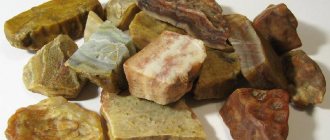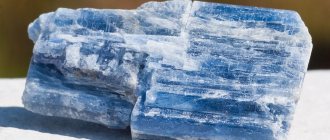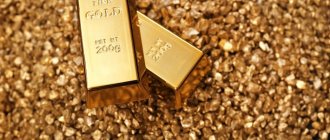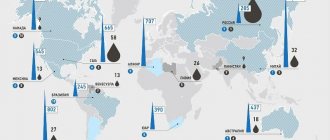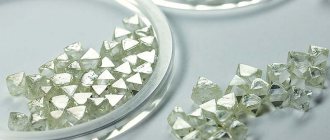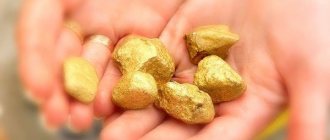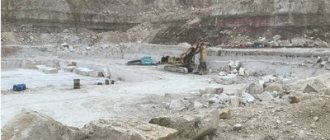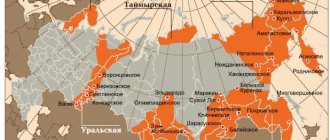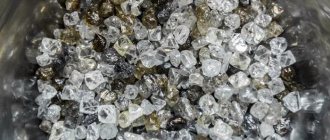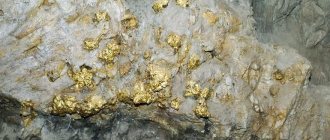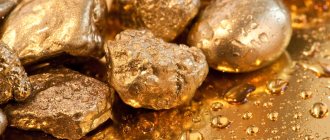Minerals are valuable formations located inside and partially above the earth’s crust; their physical and chemical properties, as well as composition, are valued for their ability to be used in various spheres of human activity. Fossils can be either solid, liquid or gaseous.
Accumulations of fossil resources are called deposits - in these zones they are presented in large quantities in the form of placers, veins, layers, stocks. Russian PIs are a colossal set of valuable metals, ores, combustible materials and other resources. Many of them are concentrated in greater numbers on the territory of the Russian Federation than anywhere else.
Mineral deposits in Russia
The largest country in the world has more than 20 thousand mineral deposits, estimated at 30 trillion in resource reserves. dollars. This gigantic natural wealth, almost evenly distributed across the territory of Russia, should be enough for several centuries of continuous use. Therefore, in terms of reserves of natural resources, our state occupies one of the leading places on the planet.
The economic geography of mineral resources of the Russian Federation is such that:
- The largest natural reserves of gold are concentrated in the Far East and Yakutia.
- The Yamalo-Nenets Autonomous Okrug is richest in hydrocarbons. They are partially found in Tatarstan, Bashkortostan, Udmurtia, the Orenburg region, in the Volga River basin and on Sakhalin Island.
- Silver is present in significant quantities in Eastern Siberia and the Ural Mountains.
- Non-metallic building materials have been discovered in Eastern Siberia.
- Most of the coal lies behind the Ural Range.
- Oil shale is found in areas adjacent to the Baltic Sea.
- Iron ore has been discovered on the Baltic Shield, in the Kursk region and on the Kola Peninsula.
- Uranium reserves are present in Transbaikalia.
- The Urals and Western Siberia are rich in aluminum.
- Non-ferrous metals are concentrated in Taimyr and eastern Siberia.
- Precious and semi-precious stones are common in the Ural, Altai and Sayan mountain ranges.
However, it should be noted that most natural resources are located in hard-to-reach areas and have a low content of useful components.
Mining
Development of the mining industry
It is necessary to take into account that there are global indicators and economic development features that affect the mining industry in Russia. After all, the predominant part of what was received is sent for export.
Thus, the current economic situation, falling oil prices, and the pandemic situation at the beginning of 2022 will negatively affect various industries, primarily oil and gas. Due to the falling price of “black gold,” the state and government will have to take a number of comprehensive and systemic measures to eliminate certain negative factors or to minimize them.
Don't expect anything else just yet. You will have to make every effort to realize what you can get from your own resources. After all, the state budget, in the vast majority of cases, rests on raw materials.
Main mining methods
Depending on the depth of occurrence of mineral resources, one or another method of their extraction is chosen:
- Career or open path. It is used to extract metal ore, nonmetallic building materials, and coal. This is the most economical, but at the same time quite strong impact on the soil method. Which further reduces its fertility and has a harmful effect on the environment.
- Mine or underground method. It is also called closed. This method is used for deep occurrence of mineral raw materials, ores and polymetals. Its disadvantages are significant costs and a high level of production risk for miners and miners.
- Open-underground or combined method. In fact, it combines the first two and is used in cases where minerals occur both on the surface and deep in the earth's crust.
- Borehole or geotechnological method. It is used to extract raw materials in a liquid or gaseous state. Typically, it is used to extract oil and gas, sulfur and lithium, uranium and phosphorus from drilled wells, resorting to leaching, precipitation and smelting. In order to then extract through pipes the mineral resources that are so needed in the national economy.
- Dredging method. It combines mining and mineral processing. Most often it is used in the development of placer deposits of diamonds, gold, cassiterite and platinum group metals.
Hutchinsonite
It is also a mineral grade of thallium. The color of the stone is very unusual: a grayish tint on silvery-white metal. The mineral looks like lead, but it is much more dangerous. You can easily find this danger in the mountains of Europe. Also occurs near volcanoes or sulfur deposits.
The effect of stone on the human body is very strange. You may notice hair loss and various diseases. And this is from a single touch of the mineral. Hutchinsonite contains three dangerous components: thallium, arsenic and lead. When used individually, they are harmful to human health, but taken together they can be deadly.
Everything has been said above, examples and evidence are given. All that remains to be noted is that a person should remember to be careful in his daily life. After all, even a grandmother at the market selling pebbles can ruin not only her own life, but also the lives of her neighbors...
Fuel and energy minerals
Oil
Our country ranks seventh in the world in terms of the number of proven oil reserves. Deposits estimated at 14.1 billion tons are located in 9 oil and gas provinces:
- Volga-Ural,
- Yenisei-Anabar,
- West Siberian,
- Leno-Vilyuiskaya,
- Leno-Tunguska,
- Okhotsk,
- Pricaspian,
- North Caucasus-Mangyshlak,
- Timan-Pechorskaya,
and in 3 oil and gas regions:
- Anadyrskaya,
- East Kamchatka,
- Baltic.
The leader among domestic oil fields is Samotlor - 7.1 billion tons. The productive period for using the reserves of this liquid hydrocarbon fuel on the territory of our state is estimated at 22 years.
oil
Natural gas
Russia is the undisputed global leader in blue fuel reserves, the total volume of which is estimated at 40 billion tons with a production prospect of more than 80 years.
The largest part of it (over 75%) falls on the deposits of Siberia. The largest among them are: Urengoyskoe – 10 trillion. m3 and Yamburgskoye – 8.9 trillion. m3.
Coal
According to the reserves of this natural resource, estimated at 2.23 trillion. t, Russia is in third place. Moreover, a significant part of the deposits – 69% – is brown coal. Most of the reserves, accounting for 63% of this valuable energy resource, are located in the eastern part of the country:
- The Kuznetsk coal basin is one of the largest in the world, with gigantic reserves of hard and coking coal.
- Kansko-Achinsky (brown coal).
- Pechersky.
- South Yakutsk.
The majority of domestic coal mining - 75% - is carried out using the closed mine method, which significantly increases its cost.
coal
Oil shale
Most of the oil shale deposits are located in the European part of Russia, in the Leningrad and Samara regions. There are also large deposits in the north of the country and in Siberia.
However, they are not actively developed due to competition from more common fuels such as oil and gas. Perhaps it will be started after the main hydrocarbon reserves have been exhausted.
Uranus
In terms of reserves of this natural resource, Russia is confidently in the top ten. According to studies five years ago, its reserves amount to 507.8 thousand tons, which is a tenth of the world's uranium resources. The main deposits are concentrated in Yakutia and Buryatia and in the Trans-Baikal Territory.
Peat
Peat extraction in Russia has little financial support from the state. In connection with this, in recent years there has been a downward trend in production. This is also associated with a drop in demand, because as you know, the main consumers of raw materials are the fuel complex and agriculture. Peat production in the country is concentrated in the Northwestern Federal District. The second largest deposit is located in the Central Federal District. The third largest peat production region is the Volga Federal District. European countries such as Finland, Belarus, and Ireland are ahead of the Russian Federation in peat extraction.
Metal fossils
Metals play a vital role in society. Without them, it is impossible to imagine either industrial production or the life of modern people.
Ferrous metal ores
Ferrous metals include iron and its alloys: steel, cast iron and ferroalloys. Their ores are divided into groups named after the main mineral:
- Red iron ores or hematites are iron oxides (Fe2O3), most used in ferrous metallurgy; and also used as a dye, known as red lead.
- Magnetic iron ore or magnetites, which are iron oxides and iron oxides (FeO and Fe2O), are distinguished by their magnetic properties.
- Brown ironstones or goethites, also called limonite or bog ore, are hydrous iron oxides. Their value lies in the fact that they can be directly used in the process of smelting iron in blast furnaces. The most valued by metallurgists is limonite from the Kerch deposit, which contains vanadium, manganese and phosphates.
- Spar iron ores or siderites are gray minerals containing iron carbonate (FeCO3). Russia is the world leader in iron ore deposits: proven reserves are estimated at 264 billion tons.
black ore
Non-ferrous metal ores
A significant part of minerals is called non-ferrous metals - these are all metals except iron, which received their name for their specific color.
The raw ores of these metals are characterized by extremely low metal content and very diverse composition. It is not surprising that they are called polymetallic ores. In this regard, in non-ferrous metallurgy there is often a complex use of natural raw materials.
Depending on density, they are divided into ores of light metals: aluminum, titanium, potassium, calcium, lithium, magnesium. And ores of heavy metals: copper, tin, lead, zinc.
Rare metal ores
A vast group of 36 chemical elements received their name purely for historical reasons. In fact, they are found in nature no less often, and sometimes much more often than ferrous, non-ferrous and noble metals.
Rare metal ores either occur independently or are present incidentally during the development of other minerals. A significant part of rare metals is extracted from non-ferrous metal ores, as well as from other minerals: germanium from brown coals, vanadium from iron and titanium ores, hafnium and rubidium from ores of other rare metals.
On the territory of Russia, significant accumulations of rare metal ores have been discovered in the Caucasus, the Urals, Siberia, the Far East, and also in Yakutia (Tomtor deposit).
Rare metal ores
Precious metal ores
This group includes precious metals: gold and silver, as well as platinum and platinum group metals: iridium, osmium, palladium, rhodium and ruthenium, which are resistant to oxidation and corrosion.
Our state has significant reserves of precious metal deposits:
- Gold – 25 thousand tons. Of these, 4/5 are ore deposits, 1/5 are placer deposits. The most significant are the Bodaibo gold deposit in Eastern Siberia and the Bam gold deposit in the Far East.
- Silver. In terms of its reserves, Russia holds first place in the world, having 16 direct deposits of silver (27% of all-Russian reserves) and a number of complex deposits. The first of them are located in Chukotka and Yakutia.
- Platinum group metals – 6-10 thousand tons, which is the third figure in the global list. The leading positions in the industry are occupied by the Nizhny Tagil field in the Urals and the Fedorov-Panskoye field in the Murmansk region.
Uranium deposits
As you know, its main use is the production of nuclear weapons, but the properties of uranium allow it to be used in very different fields. For example, nuclear engines are used in submarines, uranium is added to glass to give it color, it is also used in photography and many other industries, being part of complex alloys.
Why should you invest in gold
and other precious metals?
The earth's crust contains small amounts of uranium. However, Russia has its own deposits. The Zherlovoe and Argunskoye deposits account for 93% of reserves. 5 deposits in the Republic of Buryatia.
Non-metallic fossils
Non-metallic or non-metallic natural resources, used in their direct form for construction and industry or as raw materials, occur in nature in the form of minerals or rocks.
Mining chemical raw materials
Mining raw materials for chemical production are:
- Apatity. On the territory of our state there is the largest apatite deposit on the Kola Peninsula (Khibiny).
- Barytes. Used to produce barium salt, glaze and enamel.
- Borats. Act as water softeners in the production of washing powders.
- Phosphate ores. Russia has more than two hundred large deposits of phosphorites.
- Sulfur, largely used in the production of sulfuric acid. Large reserves of this natural raw material are located in the Samara region, the Urals (sulfur pyrites), Kamchatka, and the Kuril Islands.
Mining chemical raw materials
Mining raw materials
This type of minerals includes materials used in metallurgy, as well as in the production of abrasives, dielectrics, ceramics, glass and thermal insulation materials. The main minerals used as mining raw materials are:
- various clays, dolomites, limestones, quartz sands, porcelain stones;
- anhydride, gypsum, perlite, dolomites, limestones, talc, graphite and much more.
Optical materials
Materials of natural or artificial origin that are transparent and intended for the manufacture of optical devices. These are mainly glasses, photositalls (synthesized materials) and single crystals.
Sri Lanka
This country has already been mentioned as a center for the extraction of special types of precious stones. But there are several noteworthy nuances in the developments themselves. The extraction of precious stones there is done manually; automation is used only as pumps for pumping out groundwater. The mines themselves are dug directly in the rice fields; large working equipment is not used during excavations, so as not to create swamps.
Sri Lanka is famous for its variety of minerals and stones; about half of the varieties of all known jewelry can be found here. But the state is not involved in the development of deposits; for this there are special prospectors who pay an official license annually.
Salts and brines
A group of minerals that have a salty taste and easily dissolve in water. According to their chemical composition, they are divided into borates, halides, iodites, carbonates, sulfates of potassium, magnesium, sodium and chlorides.
Salts and brines are used in construction, in the production of mineral fertilizers and as a food additive:
- Potassium salts. The largest Verkhnekamskoye deposit of potassium-magnesium salts (VMKMS) is located in the Perm region.
- Rock or table salt. The largest suppliers to the Russian market are:
- JSC "Bassosl", Astrakhan - 1.3 million tons per year;
- OJSC "Uralkali", Berezniki - 1.0 million tons per year;
- OJSC “Iletsksol”, Orenburg – 0.5 million tons per year.
- Gypsum or hydrous calcium sulfate is widely used in construction, medicine, and arts and crafts.
Salts and brines
Lyantorskoye
Lyantorskoye is a giant Russian oil and gas condensate field. Belongs to the West Siberian oil and gas province.
- Opening: 1965.
- Beginning of industrial production: 1978.
- Location: Khanty-Mansi Autonomous Okrug, Surgut district, on the Pim River near the city of Lyantor, 90 km from the city of Surgut.
- Estimated geological oil reserves: 2 billion tons.
- Volume of recoverable reserves: 380 million tons.
- Annual production: about 7.5 million tons.
- Operator: PJSC "Surgutneftegas".
It is geologically complex.
Precious and semi-precious stones
Minerals used in jewelry making and stone cutting. Distinctive features of precious stones are their beautiful color, bright shine, transparency, and various optical effects. In addition, they have high strength and durability.
Ornamental stones are not transparent, although they have a beautiful texture and can be easily machined. They are usually used in the decoration of buildings and some products.
Deposits of these minerals are present in the Urals (gems), Yakutia (diamonds) and Eastern Siberia.
Antimony
The focus of antimony production is Yakutia with such deposits as Sarylakh, Sentachan (95% of reserves) and Tan (5%). The country's antimony reserves are very rich and can compete with such producers as Thailand, the USA, South Africa, and Mexico. But at the same time, the content of antimony in the mineral reserves of other producing countries is no more than 5%, while in Russia its content reaches 25%. Only China can boast of a larger deposit of antimony with a comparable percentage in its composition - 20%.
Construction Materials
Natural minerals used in construction include:
- Gravel is a small, rounded stone.
- Crushed stone – sharp-angled stones, no more than 70 mm in diameter, used as filler.
- Sand is a fine-grained stone fraction up to 5 mm in size.
As well as minerals used in the production of concrete, cement and other binders.
On the territory of Russia there are 8,500 deposits of more than 100 types of non-metallic building materials. The largest of them are located in the Vyazemsk, Kirov, Moscow and Smolensk regions.
silver Age
Humanity has used 95% of its silver reserves to date. In connection with this, we will face an acute shortage in the future, as well as an increase in silver prices. The areas of its use are very diverse, in addition, its use is residue-free, i.e. any residues from production are also used. There are more than 100 silver deposits in Russia. The main deposits are Dukat and Lunnoye, located in the Magadan region, as well as the Khakanjinsko-Khabarovsk Territory. Competing countries for silver mining are China, Australia, and Peru.
Sakhalin-5
Sakhalin-5 project - East Shmidtovsky and Kaigansko-Vasyukansky areas.
- Drilling of the first well: 2004.
- Location: Sea of Okhotsk, northeastern part of the shelf of Sakhalin Island.
- Estimated geological oil reserves: 1.5 billion tons.
- Proven oil reserves: 550 million tons.
- Annual extraction of oil and gas condensate: about 18 million tons.
- Project owners: PJSC NK Rosneft (31%), British Petroleum (49%).
The Kaigansko-Vasyukansky area has an area of 7.2 thousand km2 and is located at a depth of 90-120 m.
Fedorovskoe
Fedorovskoye is a giant oil and gas field. Belongs to the West Siberian province. Named after the geophysicist Viktor Fedorov.
- Discovery: 1971, expedition of Morozov N.
- Beginning of industrial production: 1973.
- Location: Khanty-Mansi Autonomous Okrug, near the city of Surgut.
- Estimated geological oil reserves: 2 billion tons.
- Volume of recoverable reserves: 189.9 million tons (data as of the end of 2009).
- Annual production: 2004 - 12.5 million tons, 2012 - 8.275 million tons.
- Operator: PJSC "Surgutneftegas".
It has a complex structure, the thickness of the layer of oil-containing rocks in some places is from 2 to 4 meters, on top of the layer there is a gas cap 50 meters thick, and under the layer there is a layer of water of the same thickness.
Problems of development of the Arctic region:
- Harsh climate.
Severe frosts almost all year round, a long polar night, the threat of damage to offshore drilling rigs by Arctic ice, swampy tundra, which determines the seasonality of activity in many regions, and limited biological activity have an extremely negative impact on personnel and equipment
- Poor infrastructure.
The development of new deposits requires considerable investment and is subject to significant environmental risks. The Arctic will require special tankers and icebreakers. At the same time, the establishment of extended communications, supply and logistics are complicated by harsh climatic conditions;
- Feasibility
Estimates of the resource potential of less extreme areas are constantly increasing, the development of which can be economically justified and safe from an environmental point of view than the development of Arctic natural gas fields.
New Siberian Islands Recently, Novosibirsk scientists proved that the New Siberian Islands in the Arctic Ocean are of continental origin. Thus, the Russian Federation will have an increased shelf area rich in oil.
